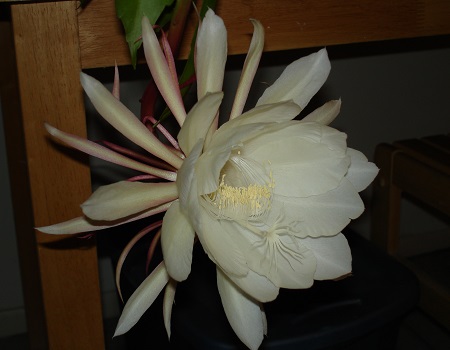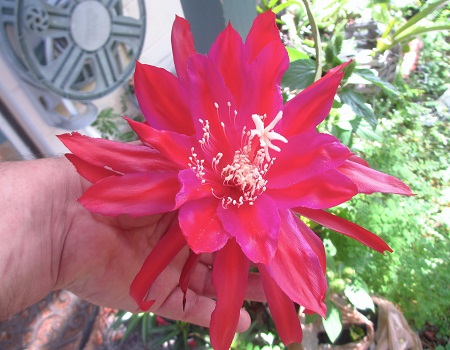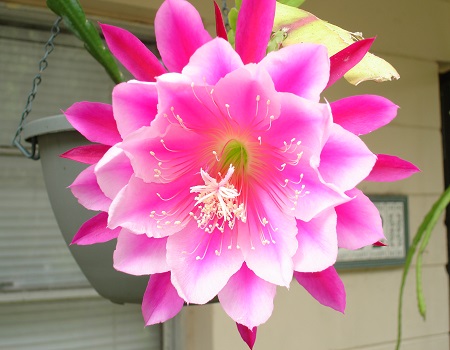These are hands down, my favorite cacti. For one thing they are tropical, and tropical plants are what I do, but even if they weren’t tropical plants, I’d still love them. They are among my favorite flowers in the world.
The colors are so vibrant, and the color combinations are frequently so unusual, that they can’t be ignored. People have been hybridizing these for many years and the results are flowers of all sizes and colors. The only color missing from the palette is blue. Care for most of the hybrids is the same from one variety to the next, so rather than talking about each variety separately, I talk about their general care here.
The foliage of these cacti is quite odd looking, but I actually find them to be very attractive. They do have small spines, but they are nowhere near as nasty as those of many of their desert dwelling brethren. They grow as flattened, strap like, or sometimes three sided, stems. Many cultivars have scalloped edges which is particularly beautiful. In Spring, flower buds form all along the sides of the stems at nodes.
I recommend growing them in hanging pots. Hanging pots are best since the foliage would otherwise be on the ground where it would rot or get damaged. The straps can hang down as far as six feet in some cultivars, but they are usually more like 2-4 feet long. The other reason that hanging pots are preferable, is that they allow for more air flow through the soil. In too heavy of a mix, or in water logged soil, they can rot, even in the Summer when they need constant moisture.
The one non-hybridized species that I sell, (Epiphyllum oxypetalum), is a bit different from the hybrids, but the difference is mostly just size.
Epiphyllum oxypetalum

The only non-hybridized species that I sell is E. oxypetalum. It is a large cactus with huge, fragrant, white, night blooming flowers. E, oxypetalum gets much larger than other Epiphyllums.
They grow tall, thin, upright, cylindrical, spires that can be ten feet long. They flare out at the top into a flat pointed blade. The flattened portion at the tip, is where the flower buds grow from. In this species, it is best to pot them in a large container, and give them a trellis of some sort to support them, or they will fall over sideways. This species will bloom all Summer long, whereas, most of the Epiphyllum hybrids only bloom in spring. As far as their water and soil needs are concerned, they are the same as the Epiphyllum hybrids.
The Key To Success
The biggest key to success with Epiphyllums is watering, and specifically, when you water them. They like to be watered frequently in the Summer, but very little in the Winter. If they are too wet when it is cold, they will rot. It is normal for them to become a bit shriveled looking in Winter, and it is actually necessary for them to have a dry cool period to initiate blooming. Once you begin watering them more regularly in Spring, they plump right up and start setting flower buds in a short time after that. Then you sit back and watch the fireworks.
Origin
Central and South America
Family
Cactaceae
Binomial nomenclature
Epiphyllum. Most of the plants in the trade, are hybrids with non-Latin cultivar names
Common names
Orchid cactus
Height
2′-8′ tall.
Temperature/Zone
zone 9a, 32°F. This plant prefers humid conditions. Frost will burn them, but they tolerate above freezing Winter temperatures fairly well, and most cultivars need a cool, dry, rest period to initiate blooming.
Light
Bright shade, to part sun.
Water
Keep them evenly hydrated in the Summer, but allow them to dry out during the Winter. If they are kept too wet in Winter, they will rot.
Fertilizer
I use fertilizer formulated for epiphytic orchids. Thy will bloom more profusely if they are fed with a bloom food in late Winter.
Cultivation
Epiphyllums need a light airy, well draining mix. I use a good potting soil, and then mix in extra perlite, and some orchid bark as well.
Pests
Florida velvet slugs will eat tender new growth and flowers



What are the best growing conditions for Epi’s? How much light, water, and fertilizer do they need?
They do best in bright shade, they need more water in Summer and very little in Winter. I use orchid fertilizer monthly.